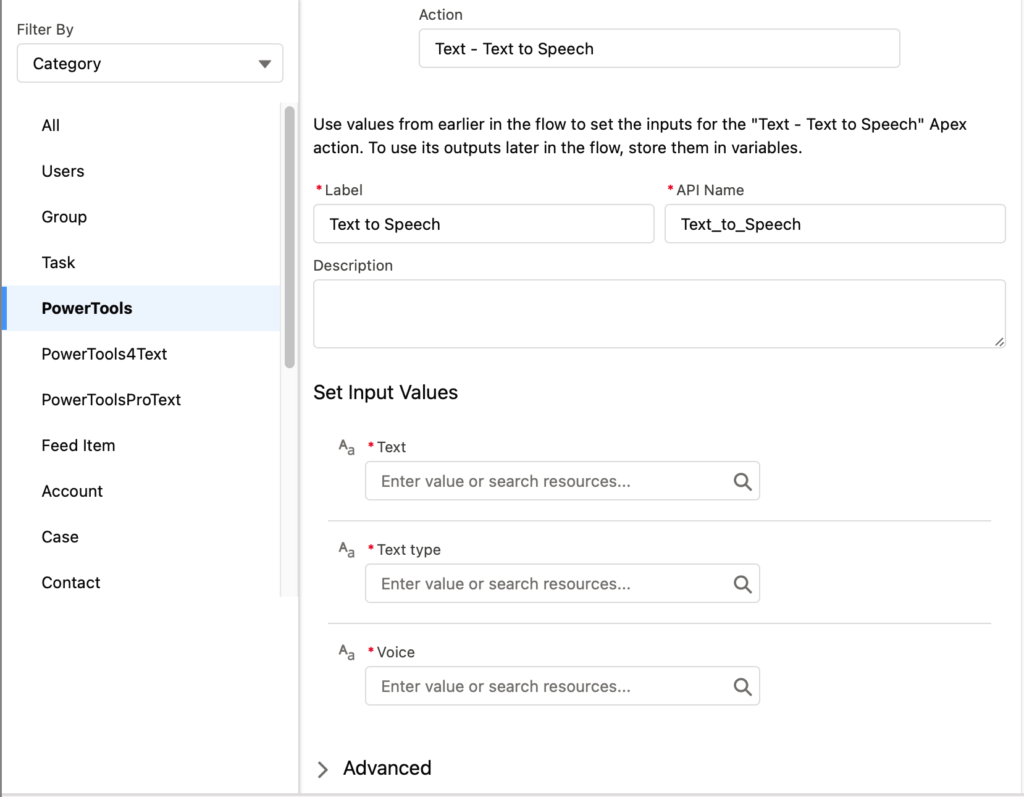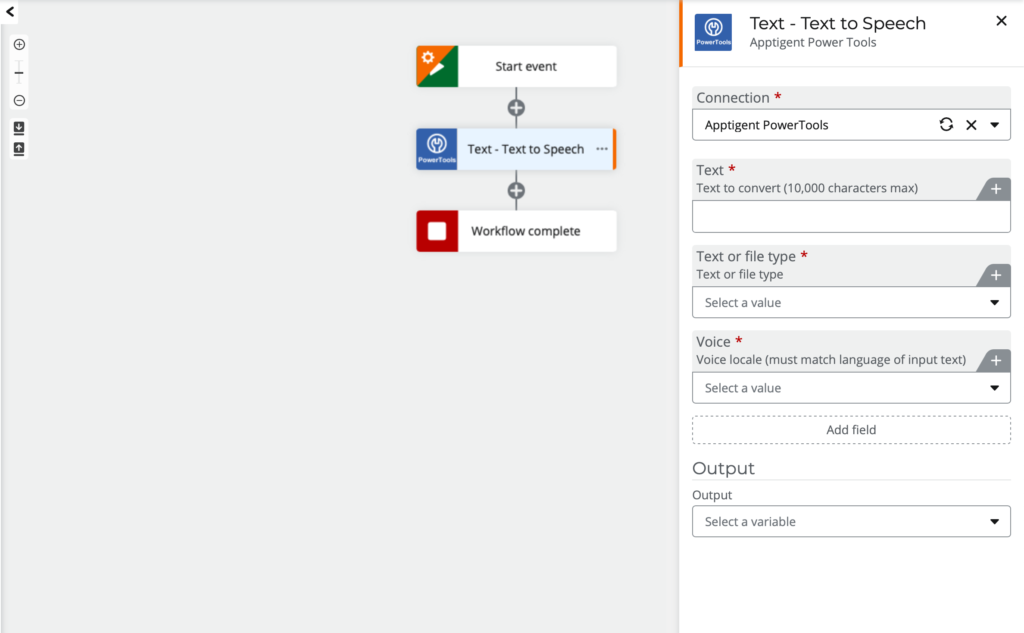
Text to Speech
Build flows and apps that convert plain text or SSML into speech in Microsoft Power Platform and other automation platforms.
15 Nov

Convert plain text or SSML into speech
The “Text to Speech” action converts a string of text or SSML into the spoken word.
Not all website visitors can easily consume the printed word and some disabled persons have difficulty interacting with text-rich applications. Converting that text to audio that people can hear instead of read can help communicate important information to your entire audience.
The “Text to Speech” action in PowerTools allows you to easily convert strings of text into audio by specifying a text file to convert and selecting a voice from over a dozen languages. For more advanced scenarios where inflection and distinct verbalizations are important, our AI-driven conversion service accepts Speech Synthesis Markup Language (SSML) files to produce pitch-perfect results.
Parameters
| Title | Name | Type | Description |
|---|---|---|---|
Text | input | string | Source text to convert |
Type | type | string | Text or file Type |
Voice | voice | string | Voice locale (must match input text language) |
Response
Status | Title | Name | Type | Description |
|---|---|---|---|---|
Success | Result | result | file | Audio file (mp3) |
Failure | Result | result | string | Error description |
- How to convert plain text or SSML into speech in Microsoft Power Automate
- How to convert plain text or SSML into speech in Microsoft Power Apps
- How to convert plain text or SSML into speech in Salesforce
- How to convert plain text or SSML into speech in Nintex
- How to convert plain text or SSML into speech in Custom API
How to convert plain text or SSML into speech in Microsoft Power Automate
Instructions
- In the Flow designer, click the “+” icon to insert a new action.
- Select the “Text – Text to Speech” action under PowerTools in the “Choose an operation” dialog.
- Insert the necessary values or variables in each input field.
- Execute the flow.
Example

Video

How to convert plain text or SSML into speech in Microsoft Power Apps
Instructions
- Add the PowerTools connector from the Data menu.
- In the formula for the control, variable or element, type “ApptigentPowerTools.TextToSpeech().result”. Within the parentheses, enter the field, control or variable that contains the source collection.
- Preview or run the app.
Example
Coming soon
Video

How to convert plain text or SSML into speech in Salesforce
Instructions
- Drag and drop a new action onto the design surface. Edit the action and choose PowerTools from the category menu on the left.
- Click in the “Action” search box, scroll through the action list and choose “Text – Text to Speech”. Insert the necessary values or variables in each input field. (Note: Click the “Advanced” link to manually assign output variables to the action results)
- Run or Debug your flow to preview the results.
Example

Video

How to convert plain text or SSML into speech in Nintex
Instructions
- Locate the “Apptigent PowerTools” group in the actions navigator then drag and drop the “Text – Text to Speech” action onto the design surface.
- Insert the necessary values or variables in each input field.
- Assign the result to a variable.
- Test the workflow.
Example

Video

How to convert plain text or SSML into speech in another Platform or Custom Code
Instructions
If your platform is not listed and it supports Open API (Swagger) extensions, import the API Definition document from the Developer Edition product on our Customer Portal at https://portal.apptigent.com/product (look for the Open API link at the top of the PowerTools Developer API definition page). Invoke the desired actions in your app or workflow design tool, supplying values for the listed parameters. Refer to the developer documentation on the Customer Portal for details on input and output formats.
If you are developing a custom app, execute a RESTful POST operation to the /CountCollection endpoint in your application code or use the pre-generated client scaffolding from our Github repo at https://github.com/apptigent/powertools. Be sure to include your API Key (Client ID) in the header using the “X-IBM-Client-Id” key/value pair. The body should be a well-formed JSON object with the parameter label(s) and value(s) in the specified format. Refer to the API documentation at https://portal.apptigent.com for more information.
Example
const request = require('request');
const options = {
method: 'POST',
url: 'https://connect.apptigent.com/api/utilities/TextToSpeech',
headers: {
'X-IBM-Client-Id': 'REPLACE_THIS_KEY',
'content-type': 'application/json',
accept: 'audio/mp3'
},
body: {text: 'This is sample text.', type: 'PlainText', voice: 'en-US, Aria (Female)'},
json: true
};
request(options, function (error, response, body) {
if (error) throw new Error(error);
console.log(body);
});





